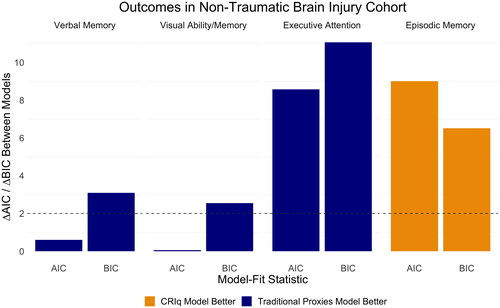Figures & data
Table 1. Demographic and injury characteristics for participants.
Table 2. Cognitive Reserve Index questionnaire total and subscale scores for participants.
Table 3. Correlations between Cognitive Reserve Index questionnaire subscale scores.
Figure 1. Traumatic brain injury cohort (n = 105) model-fit statistics comparing models with CRIq subscales scores as independent variables to a traditional proxies model with premorbid IQ and years of education as independent variables, for all outcome variables. AIC, Akaike Information criterion; BIC, Bayesian Information criterion; CRIq, Cognitive Reserve Index questionnaire; TBI, traumatic brain injury. ΔAIC and ΔBIC represent the differences in AIC and BIC between the two models for each outcome, respectively. ΔAIC or ΔBIC > 2 were considered supportive of a better model fit. ΔAIC of 3–7 or ΔBIC of 2–6 indicate small/moderate evidence, and values > 10 indicate strong evidence for a better model fit.

Table 4. Best fit-model statistics for regression models with either Cognitive Reserve Index questionnaire subscales or traditional proxies as independent variables.
Figure 2. Non-traumatic brain injury cohort (n = 91) model-fit statistics comparing models with CRIq subscales scores as independent variables to a traditional proxies model with IQ and years of education as independent variables, for all outcome variables. AIC, Akaike Information criterion; BIC, Bayesian Information criterion; CRIq, Cognitive Reserve Index questionnaire. ΔAIC and ΔBIC represent the differences in AIC and BIC between the two models for each outcome, respectively. ΔAIC or ΔBIC > 2 were considered supportive of a better model fit. ΔAIC of 3–7 or ΔBIC of 2–6 indicate small/moderate evidence, and values > 10 indicate strong evidence for a better model fit.

Supplemental Material
Download MS Word (18.9 KB)Supplemental Material
Download MS Word (27.9 KB)Supplemental Material
Download MS Word (15.1 KB)Data availability statement
De-identified data from this study are not available in a public archive. De-identified data from this study will be made available (as allowable according to institutional IRB standards) by emailing the corresponding author as of April 2022.
